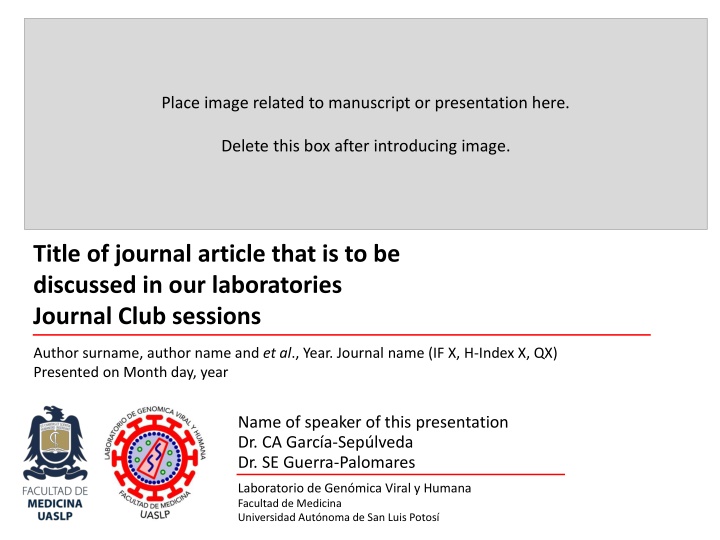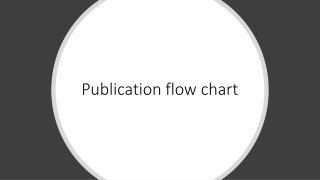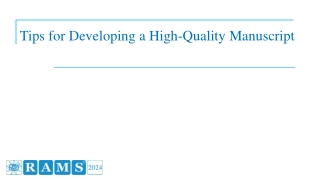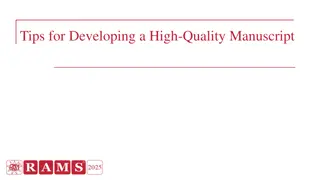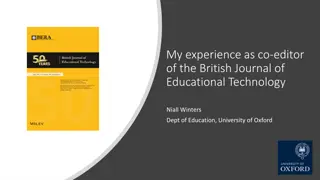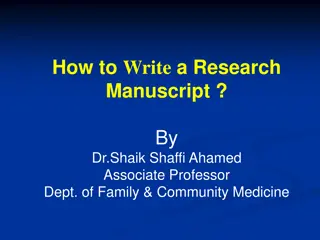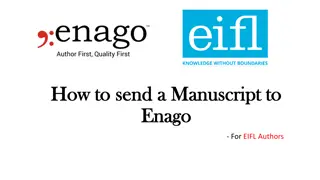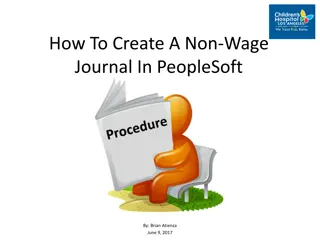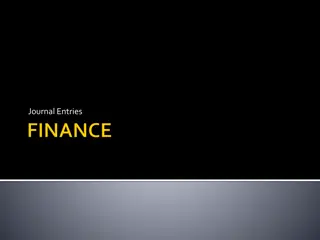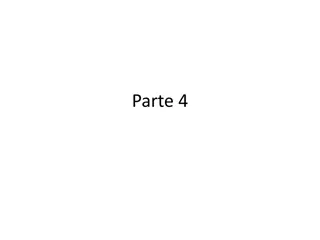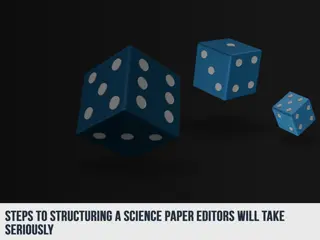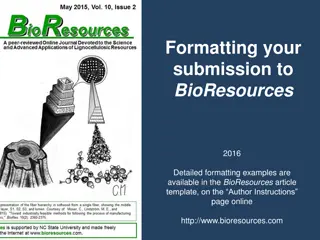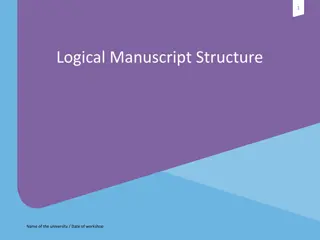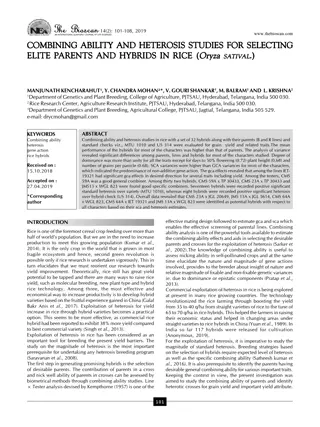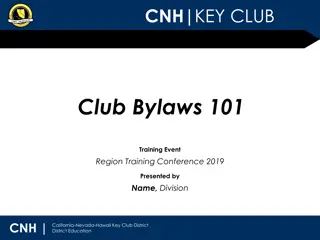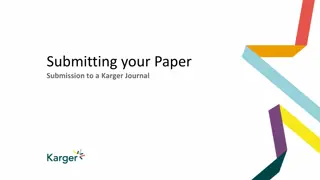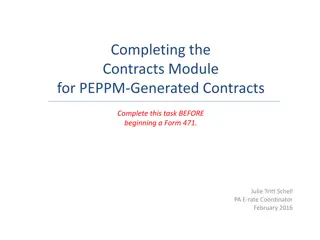Manuscript Presentation for Journal Club Session
This presentation covers a journal article to be discussed in laboratories Journal Club sessions. It includes summaries of the aim of the article, introduction, results, conclusions, and materials & methods of the study.
Download Presentation

Please find below an Image/Link to download the presentation.
The content on the website is provided AS IS for your information and personal use only. It may not be sold, licensed, or shared on other websites without obtaining consent from the author.If you encounter any issues during the download, it is possible that the publisher has removed the file from their server.
You are allowed to download the files provided on this website for personal or commercial use, subject to the condition that they are used lawfully. All files are the property of their respective owners.
The content on the website is provided AS IS for your information and personal use only. It may not be sold, licensed, or shared on other websites without obtaining consent from the author.
E N D
Presentation Transcript
Place image related to manuscript or presentation here. Delete this box after introducing image. Title of journal article that is to be discussed in our laboratories Journal Club sessions Author surname, author name and et al., Year. Journal name (IF X, H-Index X, QX) Presented on Month day, year Name of speaker of this presentation Dr. CA Garc a-Sep lveda Dr. SE Guerra-Palomares Laboratorio de Gen mica Viral y Humana Facultad de Medicina Universidad Aut noma de San Luis Potos
Title Calibri (body) 24 pts black, do not change size of this box DO NOT MODIFIY TEMPLATE LAYOUT, FONT TYPE OR SIZE, DO NOT MOVE BOXES! Text here for slide presenting only horizontal text. Place text headings here. Avoid bullets as much as possible. Only use bullets for subheadings like these. Please keep sentences brief, use as little words as possible to convey message. Body text is Calibri (body) 18 pts black in colour, single spacing, single column. If using line art, boxes, lines or arrows stick to black colour then RGB. Always use MS Powerpoint s tool to check spelling and grammar. Do not animate slides or add transitions. 2 Distributed through a Creative Commons Attribution (BY) license granting the licensee the right to copy, distribute, display and make derivative works based on this document, including commercial use, as long as they credit the author as Laboratorio de Genomica Viral y Humana, Facultad de Medicina UASLP .
Title Calibri (body) 24 pts black, do not change size of this box Text here for slide with vertical text and tall image, graph or figure. Images, graphs or tables here. Remove this box for your presentation. 3 Distributed through a Creative Commons Attribution (BY) license granting the licensee the right to copy, distribute, display and make derivative works based on this document, including commercial use, as long as they credit the author as Laboratorio de Genomica Viral y Humana, Facultad de Medicina UASLP .
Title Calibri (body) 24 pts black, do not change size of this box Text here for slide with horizontal text and wide image, graph or figure. Images, graphs or tables here. Remove this box for your presentation. 4 Distributed through a Creative Commons Attribution (BY) license granting the licensee the right to copy, distribute, display and make derivative works based on this document, including commercial use, as long as they credit the author as Laboratorio de Genomica Viral y Humana, Facultad de Medicina UASLP .
How to summarize and article Read title and abstract What is the aim of the article? Read manuscript thoroughly once (Fast, get an overview of structure). Review and understand all figure, table and graph details. Summarize: 1) results, 2) conclusions, 3) materials & methods and 4)introduction. Provide detailed explanation of all figures, tables and graphs included in manuscript. If you don t understand the figures, tables or graphs you haven t understood article. Concentrate your summary in this presentation in the following order: Article aim and journal info Introduction Results Conclusions Materials and Methods 5 Distributed through a Creative Commons Attribution (BY) license granting the licensee the right to copy, distribute, display and make derivative works based on this document, including commercial use, as long as they credit the author as Laboratorio de Genomica Viral y Humana, Facultad de Medicina UASLP .
Aim of the article and relevance for our lab This where you as a presenter provide insight into why this manuscript is important. For the health of the planet s human/animal population or enviornment. For the health of inhabitants of Mexico, Latinamerica or North America. For our research interests. For its novely and relationship with our research interests. 6 Distributed through a Creative Commons Attribution (BY) license granting the licensee the right to copy, distribute, display and make derivative works based on this document, including commercial use, as long as they credit the author as Laboratorio de Genomica Viral y Humana, Facultad de Medicina UASLP .
How to read a scientific paper Read this scientific paper: (click on image to go to open access pdf document): https://www.ncbi.nlm.nih.gov/pmc/articles/PMC7392212/pdf/pcbi.1008032.pdf 7 Distributed through a Creative Commons Attribution (BY) license granting the licensee the right to copy, distribute, display and make derivative works based on this document, including commercial use, as long as they credit the author as Laboratorio de Genomica Viral y Humana, Facultad de Medicina UASLP .
Scientific article selection criteria Each presenter is responsible for independently selecting an article from PubMed. Article selection must be approved by a principal or associate researcher before distribution and presentation. Article should be related to the presenter s area of study, thesis topic, or the broader research interests of our lab. Articles should have been published within the last 3 years to ensure the information is current and preference should be given to journals with IF 2 and Q1 or Q2. The article should offer learning opportunities for all participants either through new concepts, experimental approaches, or interpretation of complex data. Articles must be written and presente in English to facilitate discussion and alignment with LGVH s commitment to bilingual scientific communication. All images, tables, figures included in article should be clearly explained. 8 Distributed through a Creative Commons Attribution (BY) license granting the licensee the right to copy, distribute, display and make derivative works based on this document, including commercial use, as long as they credit the author as Laboratorio de Genomica Viral y Humana, Facultad de Medicina UASLP .
Journal Club Rules Presenters shall submit article of interest to principal or associate researchers at minimum ONE WEEK before the scheduled presentation date. Presenters shall distribute article of interest to rest of the staff via WhatsApp LGVH Admin group. Presentations will be suspended without notice if presenter fails to attend these two previous indications. Presentations having spelling or grammar mistakes will be returned for corrections and will not be included in either our website or Facebook / YouTube channels. 9 Distributed through a Creative Commons Attribution (BY) license granting the licensee the right to copy, distribute, display and make derivative works based on this document, including commercial use, as long as they credit the author as Laboratorio de Genomica Viral y Humana, Facultad de Medicina UASLP .
Take-away, Food for thought What are the most important facts included in the introcution of this article? What are the most important results mentioned in this article? What are the authors conclusions? How is this important to you, Mexico or our research? 10 Distributed through a Creative Commons Attribution (BY) license granting the licensee the right to copy, distribute, display and make derivative works based on this document, including commercial use, as long as they credit the author as Laboratorio de Genomica Viral y Humana, Facultad de Medicina UASLP .
Laboratorio de Genmica Viral & Humana BSL-3, Facultad de Medicina UASLP Dr. Christian A. Garc a-Sep lveda (Operaciones BSL-3, Virolog a Molecular) Dra. Sandra E. Guerra-Palomares (Operaciones BSL-3, Virolog a Molecular) LTS. Dulce M. Hern ndez Pi a (Lab Manager) Dr. Andreu Comas Garc a (Epidemiolog a molecular) Dra. Sofia Bernal Silva (Virolog a molecular) Dr. Fernando D az-Barriga Mart nez (One Health) Dr. Guillermo Espinosa Reyes (Salud y Toxicolog a Ambiental) Dr. Mauricio Comas Garc a (Microscop a electr nica y virolog a estructural) Dr. Roberto Gonz lez Amaro (Inmunolog a) Dr. Juan Carlos Cuevas Tello (Aplicaciones de algoritmos de inteligencia artificial) Biol. Ignacio Amezcua Osorio (Trabajo de campo con murci lagos) MVZ. Carolina Escalante Vargas (Trabajo de campo con murci lagos) Laboratorio Nacional de Vacunolog a y Virus Tropicales, Escuela Nacional de Ciencias Biol gicas IPN Dra. Ma. Isabel Salazar S nchez (Virolog a molecular e inmunolog a) Dr. Jes s Miguel Torres Flores (Operaciones BSL-3) Dr. Joel Armando V zquez P rez (Vir logo especializado en Influenzavirus) Dr. Rosa Elena Sarmiento Silva (Vir loga especializada en virus respiratorios) Departamento de Inmunolog a del Instituto de Investigaciones Biom dicas UNAM Dra. Clara In s Espitia Pinz n (Operaciones BSL-3) Dr. Antonio Garc a Knight (Inmun logo viral con nfasis en virus emergentes) Dr. Renato Le n Rodr guez (Virolog a molecular) Dr. Wenceslao Coronado Aceves (Evaluaci n de f rmacos in vitro e in vivo) Dra. Georgina Diaz Herrera (M dica Veterinaria peque as especies) Maestra Erika Segura Salinas (Evaluaci n de f rmacos potenciales)
Viral & Human Genomics Laboratory A Biosafety Level 3 (BSL-3 ) High-Biocontainment Facility and member of the WHO Collaborating Centre on Health Risk Assessment San Luis Potos State University, School of Medicine
